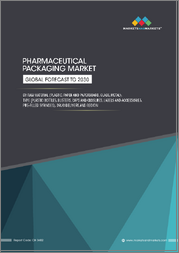
|
시장보고서
상품코드
1625213
워시 오프 라벨 시장 예측(-2030년) : 접착제 유형, 재료, 기술, 용도, 최종사용자, 지역별 세계 분석Wash-Off Labels Market Forecasts to 2030 - Global Analysis By Adhesive Type, Material Type (Paper Labels, Polyethylene Terephthalate Labels, Plastic Labels and Vinyl Labels), Technology, Application, End User and By Geography |
||||||
Stratistics MRC에 따르면 세계의 워시 오프 라벨 시장은 2024년에 16억 달러를 차지하며 예측 기간 중 CAGR은 7.5%로 성장하며, 2030년에는 24억 달러에 달할 것으로 예측됩니다.
세척 라벨은 세척 및 청소 과정에서 쉽게 떼어낼 수 있도록 설계된 포장 라벨의 일종으로, 주로 용기나 병에 사용됩니다. 일반적으로 물이나 세제에 닿으면 녹거나 벗겨지는 특수 접착제 또는 재료로 만들어지며 잔류 물이 남지 않습니다. 이 라벨은 음료수 병, 병, 식품 용기와 같이 포장을 적절하게 재활용하거나 재사용하기 위해 깨끗하게 벗겨야 하는 용기에서 흔히 볼 수 있습니다.
개봉방지 포장 사용 증가
시장에서 변조 방지 포장의 사용 증가는 안전과 보안에 대한 소비자의 요구가 증가함에 따라 주도하고 있습니다. 변조 방지 기능은 제품이 변조되거나 훼손되지 않았는지 확인하여 신뢰와 브랜드 신용을 높이는 데 도움이 됩니다. 이러한 추세는 안전이 최우선 순위인 식품, 식품 및 음료 및 제약 산업에서 특히 두드러집니다. 규제 요건이 강화됨에 따라 소비자 보호 및 안전 표준을 준수하려는 브랜드에게 변조 방지 기능이 있는 워시오프 라벨은 효과적인 솔루션이 될 수 있습니다.
워시 오프 라벨의 장점에 대한 인식이 낮습니다.
시장에서 워시오프 라벨의 장점에 대한 인식이 낮기 때문에 보급에 어려움을 겪고 있습니다. 많은 기업은 쉽게 떼어낼 수 있고 재활용이 용이하다는 환경적, 업무적 이점을 알지 못한 채 기존의 라벨링 방식에 의존하고 있습니다. 이러한 지식 부족은 보다 지속가능하고 효율적인 포장 솔루션으로의 전환을 지연시키고, 시장 성장을 제한하며, 기업이 비용 절감과 친환경 제품에 대한 소비자 선호를 활용하는 것을 방해할 수 있습니다.
독특한 기능을 가진 라벨에 대한 수요 증가
시장에서 독특한 기능을 가진 라벨에 대한 수요가 증가하고 있는 것은 커스터마이징과 브랜드 차별화를 선호하는 소비자의 취향에 힘입은 것입니다. 브랜드는 친환경 소재와 혁신적인 디자인 등 미적, 기능적, 지속가능성을 갖춘 라벨을 원하고 있습니다. 수용성 접착제, 보안 마크, 선명한 그래픽과 같은 독특한 기능은 시각적 매력과 제품 신뢰도가 고객을 끌어들이는 데 중요한 역할을 하는 식품, 음료, 화장품 등의 산업에서 선호되고 있습니다.
리사이클링의 과제
재활용 시장이 해결해야 할 과제는 시장의 성장과 지속가능성 노력을 크게 저해할 수 있습니다. 부적절한 접착 제거 및 부적절한 라벨링 재료는 재활용 흐름을 오염시키고 재활용 프로세스의 효율성을 떨어뜨릴 수 있습니다. 이는 폐기물 증가와 환경 부하 증가로 이어져 시장의 친환경 목표와 모순됩니다. 이러한 문제는 제조업체가 워시오프 라벨을 채택하려는 의욕을 떨어뜨리고 순환 경제와 지속가능한 포장 솔루션에 기여할 수 있는 잠재력을 제한할 수 있습니다.
COVID-19의 영향 :
COVID-19 팬데믹은 시장에 다양한 영향을 미쳤습니다. 공급망과 제조 공정의 혼란으로 인해 처음에는 생산이 둔화되었지만, 특히 식품 및 의약품 분야에서 포장 제품에 대한 수요가 증가하여 효율적이고 안전한 라벨링 솔루션에 대한 필요성이 높아졌습니다. 또한 위생과 안전에 대한 인식이 높아지면서 변조 방지 라벨과 쉽게 떼어낼 수 있는 라벨에 대한 선호도가 높아져 시장의 혁신과 보급을 촉진했습니다.
예측 기간 중 종이 라벨 분야가 가장 큰 분야가 될 것으로 예상됩니다.
종이 라벨 분야는 예측 기간 중 가장 큰 시장 점유율을 차지할 것으로 예상됩니다. 생분해성 재료로 만들어진 종이 라벨은 특히 식품 및 음료와 같은 산업에서 포장에 대한 지속가능한 솔루션을 제공합니다. 재활용 과정에서 쉽게 떼어낼 수 있으며, 오염을 최소화하고 순환 경제를 촉진합니다. 지속가능성이 우선시됨에 따라 종이 세척 라벨은 환경 친화적인 브랜드에게 선호되는 선택이 되고 있습니다.
화장품 용기 분야는 예측 기간 중 가장 높은 CAGR을 보일 것으로 예상됩니다.
화장품 용기 분야는 예측 기간 중 가장 높은 CAGR을 나타낼 것으로 예상됩니다. 친환경 포장에 대한 수요가 증가함에 따라 워시오프 라벨은 잔류물을 남기지 않고 쉽게 떼어낼 수 있으며, 재활용 활동을 지원하는 실용적인 솔루션을 제공합니다. 이러한 추세는 포장이 제품 프레젠테이션과 소비자 인식에 중요한 역할을 하는 화장품 업계에서 특히 중요하며, 환경 친화적인 소비자의 취향에 부합하는 화장품 업계에서 특히 중요합니다.
가장 큰 점유율을 차지하는 지역
북미는 지속가능하고 친환경적인 포장 솔루션에 대한 소비자 수요 증가로 인해 예측 기간 중 가장 큰 시장 점유율을 차지할 것으로 예상됩니다. 식품 및 음료, 화장품, 의약품 등의 업계는 환경 규제와 소비자 선호도를 충족시키기 위해 세척 가능한 라벨을 채택하고 있으며, 쉽게 떼어낼 수 있고 재활용이 가능한 워시오프 라벨을 채택하고 있습니다. 지속가능성에 대한 인식이 높아짐에 따라 브랜드들은 워시오프 라벨을 활용해 환경에 미치는 영향을 줄이면서 브랜드 이미지를 강화하는 데 활용하고 있습니다.
CAGR이 가장 높은 지역 :
예측 기간 중 아시아태평양이 가장 높은 성장률을 나타낼 것으로 예상됩니다. 환경 지속가능성에 대한 인식이 높아지면서 포장에 워시오프 라벨을 채택하는 주요 원동력이 되고 있습니다. 이러한 라벨은 특히 재사용을 위해 세척이 필요한 병과 병의 재활용 과정에서 폐기물을 줄일 수 있는 솔루션으로 여겨지고 있습니다. 또한 특히 식품 및 음료 분야에서 고품질, 미적, 기능적 포장에 대한 수요가 증가함에 따라 제조업체들은 포장 솔루션에 대한 혁신을 추진하고 있습니다.
무료 커스터마이징 제공:
이 보고서를 구독하는 고객은 다음과 같은 무료 맞춤화 옵션 중 하나를 사용할 수 있습니다. :
- 기업 개요
- 추가 시장 기업 종합 프로파일링(최대 3사)
- 주요 기업의 SWOT 분석(최대 3사)
- 지역 세분화
- 고객의 관심에 따른 주요 국가별 시장 추정치, 예측, CAGR(주: 타당성 확인에 따라 다름)
- 경쟁사 벤치마킹
- 제품 포트폴리오, 지역적 입지, 전략적 제휴를 기반으로 한 주요 기업 벤치마킹
목차
제1장 개요
제2장 서문
- 개요
- 이해관계자
- 조사 범위
- 조사 방법
- 데이터 마이닝
- 데이터 분석
- 데이터 검증
- 조사 어프로치
- 조사 정보원
- 1차 조사 정보원
- 2차 조사 정보원
- 전제조건
제3장 시장 동향 분석
- 촉진요인
- 억제요인
- 기회
- 위협
- 기술 분석
- 용도 분석
- 최종사용자 분석
- 신흥 시장
- COVID-19의 영향
제4장 Porter's Five Forces 분석
- 공급 기업의 교섭력
- 바이어의 교섭력
- 대체품의 위협
- 신규 진출업체의 위협
- 경쟁 기업 간 경쟁 관계
제5장 세계의 워시 오프 라벨 시장 : 접착제 유형별
- 리무버블 접착제
- 워시오프 접착제
제6장 세계의 워시 오프 라벨 시장 : 재료별
- 종이 라벨
- 폴리에틸렌 테레프탈레이트(PET) 라벨
- 플라스틱 라벨
- 비닐 라벨
제7장 세계의 워시 오프 라벨 시장 : 기술별
- 플렉소 인쇄
- 오프셋 인쇄
- 디지털 인쇄
제8장 세계의 워시 오프 라벨 시장 : 용도별
- 음료 보틀
- 관
- 화장품 용기
- 약병
- 프로모션 라벨
- 자동차 부품
- 기타 용도
제9장 세계의 워시 오프 라벨 시장 : 최종사용자별
- 식품 및 음료
- 화장품·퍼스널케어 제품
- 의약품
- 소매·소비재
- 자동차·산업용 제품
- 기타 최종사용자
제10장 세계의 워시 오프 라벨 시장 : 지역별
- 북미
- 미국
- 캐나다
- 멕시코
- 유럽
- 독일
- 영국
- 이탈리아
- 프랑스
- 스페인
- 기타 유럽
- 아시아태평양
- 일본
- 중국
- 인도
- 호주
- 뉴질랜드
- 한국
- 기타 아시아태평양
- 남미
- 아르헨티나
- 브라질
- 칠레
- 기타 남미
- 중동 및 아프리카
- 사우디아라비아
- 아랍에미리트
- 카타르
- 남아프리카공화국
- 기타 중동 및 아프리카
제11장 주요 발전
- 계약, 파트너십, 협업, 합병사업
- 인수와 합병
- 신제품 발매
- 사업 확대
- 기타 주요 전략
제12장 기업 프로파일링
- Avery Dennison Corporation
- Tesa SE
- Sonoco Products Company
- Mondi Group
- Henkel AG & Co. KGaA
- Nekoosa
- Herma GmbH
- Nippon Paper Industries Co., Ltd.
- CCL Industries Inc.
- Cenveo Worldwide Limited
- Amcor Limited
- Label Solutions
- Zebra Technologies
- Koehler Paper Group
- Scandicrafts
According to Stratistics MRC, the Global Wash-Off Labels Market is accounted for $1.6 billion in 2024 and is expected to reach $2.4 billion by 2030 growing at a CAGR of 7.5% during the forecast period. Wash-off labels are a type of packaging label designed to be easily removed during the washing or cleaning process, often used on containers or bottles. They are typically made with special adhesives and materials that dissolve or peel away when exposed to water or detergents, leaving no residue. These labels are commonly found on items like beverage bottles, jars, or food containers where clean removal is required to ensure proper recycling or reusability of the packaging.
Market Dynamics:
Driver:
Increasing use of tamper-evident packaging
The increasing use of tamper-evident packaging in the market is driven by rising consumer demand for safety and security. Tamper-evident features help ensure that products have not been altered or compromised, enhancing trust and brand credibility. This trend is particularly prominent in the food, beverage, and pharmaceutical industries, where safety is a top priority. As regulatory requirements tighten, tamper-evident wash-off labels provide an effective solution for brands aiming to protect consumers and comply with safety standards.
Restraint:
Limited awareness of the benefits of wash-off labels
Limited awareness of the benefits of wash-off labels in the market can hinder their widespread adoption. Many businesses remain unaware of the environmental and operational advantages, such as ease of removal and recycling, leading to continued reliance on traditional labeling methods. This lack of knowledge slows the transition to more sustainable and efficient packaging solutions, potentially limiting market growth and preventing companies from capitalizing on cost savings and consumer preference for eco-friendly products.
Opportunity:
Rising demand for labels with unique features
The rising demand for labels with unique features in the market is fueled by consumer preference for customization and brand differentiation. Brands seek labels that offer enhanced aesthetics, functionality, and sustainability, such as eco-friendly materials and innovative designs. Unique features like water-soluble adhesives, security markings, and vibrant graphics are gaining traction across industries like food, beverages, and cosmetics, where visual appeal and product authenticity play a crucial role in attracting customers.
Threat:
Challenges with recycling
Challenges with recycling in the market can significantly hinder its growth and sustainability efforts. Inadequate adhesive removal or improper labeling materials can contaminate recycling streams, reducing the efficiency of recycling processes. This leads to increased waste and environmental impact, contradicting the market's eco-friendly goals. Such challenges may discourage manufacturers from adopting wash-off labels, limiting their potential to contribute to a circular economy and sustainable packaging solutions.
Covid-19 Impact:
The COVID-19 pandemic had a mixed impact on the market. While disruptions in supply chains and manufacturing processes initially slowed production, the growing demand for packaged goods, particularly in the food and pharmaceutical sectors, fueled the need for efficient and secure labeling solutions. Additionally, heightened awareness of hygiene and safety led to an increased preference for tamper-evident and easy-to-remove labels, driving market innovation and adoption.
The paper labels segment is expected to be the largest during the forecast period
The paper labels segment is expected to account for the largest market share during the projection period. Made from biodegradable materials, paper labels offer a sustainable solution for packaging, especially in industries like food and beverages. Their ability to be easily removed during the recycling process ensures minimal contamination, promoting circular economy practices. As sustainability becomes a priority, paper wash-off labels are becoming a preferred choice for environmentally-conscious brands.
The cosmetic jars segment is expected to have the highest CAGR during the forecast period
The cosmetic jars segment is expected to have the highest CAGR during the extrapolated period. With the growing demand for eco-friendly packaging, wash-off labels provide a practical solution by allowing easy removal without leaving residue, supporting recycling efforts. This trend is particularly significant in the cosmetic industry, where packaging plays a crucial role in product presentation and consumer perception, while also aligning with environmentally-conscious consumer preferences.
Region with largest share:
North America region is projected to account for the largest market share during the forecast period driven by increasing consumer demand for sustainable and eco-friendly packaging solutions. Industries such as food and beverages, cosmetics, and pharmaceuticals are adopting wash-off labels for their ease of removal and recyclability, aligning with environmental regulations and consumer preferences. As awareness of sustainability rises, the brands are leveraging wash-off labels to enhance brand image while reducing environmental impact.
Region with highest CAGR:
Asia Pacific is expected to register the highest growth rate over the forecast period. Growing awareness about environmental sustainability is a key driver for the adoption of wash-off labels in packaging. These labels are increasingly seen as a solution to reduce waste in recycling processes, particularly for bottles and jars that need to be cleaned for reuse. Additionally, As the demand for high-quality, aesthetic, and functional packaging increases, especially in food and beverage sectors, manufacturers are innovating in packaging solutions.
Key players in the market
Some of the key players in Wash-Off Labels market include Avery Dennison Corporation, Tesa SE, Sonoco Products Company, Mondi Group, Henkel AG & Co. KGaA, Nekoosa, Herma GmbH, Nippon Paper Industries Co., Ltd., CCL Industries Inc., Cenveo Worldwide Limited, Amcor Limited, Label Solutions, Zebra Technologies, Koehler Paper Group and Scandicrafts.
Key Developments:
In October 2024, Avery Dennison has revealed its first range of INGEDE12-certified paper label solutions, using a new adhesive technology said to result in higher quality output for new cardboard and paper production. To meet PPWR guidelines for packaging recyclability, all components of a packaging unit must meet certain design for recycling criteria.
In September 2024, Koehler Paper, part of the Koehler Group, has added "Koehler NexPlus(R) Seal WVB" to its portfolio of innovative flexible packaging paper in the NexPlus(R) product line. "Koehler Nex- Plus(R) Seal WVB" is a heat-sealable paper which boasts a vapor barrier as its functional layer, thereby of- fering optimal product protection.
Adhesive Types Covered:
- Removable Adhesives
- Wash-Off Adhesives
Material Types Covered:
- Paper Labels
- Polyethylene Terephthalate (PET) Labels
- Plastic Labels
- Vinyl Labels
Technologies Covered:
- Flexographic Printing
- Offset Printing
- Digital Printing
Applications Covered:
- Beverage Bottles
- Cans
- Cosmetic Jars
- Medicine Bottles
- Promotional Labels
- Automotive Parts
- Other Applications
End Users Covered:
- Food & Beverages
- Cosmetics & Personal Care Products
- Pharmaceuticals
- Retail & Consumer Goods
- Automotive & Industrial Products
- Other End Users
Regions Covered:
- North America
- US
- Canada
- Mexico
- Europe
- Germany
- UK
- Italy
- France
- Spain
- Rest of Europe
- Asia Pacific
- Japan
- China
- India
- Australia
- New Zealand
- South Korea
- Rest of Asia Pacific
- South America
- Argentina
- Brazil
- Chile
- Rest of South America
- Middle East & Africa
- Saudi Arabia
- UAE
- Qatar
- South Africa
- Rest of Middle East & Africa
What our report offers:
- Market share assessments for the regional and country-level segments
- Strategic recommendations for the new entrants
- Covers Market data for the years 2022, 2023, 2024, 2026, and 2030
- Market Trends (Drivers, Constraints, Opportunities, Threats, Challenges, Investment Opportunities, and recommendations)
- Strategic recommendations in key business segments based on the market estimations
- Competitive landscaping mapping the key common trends
- Company profiling with detailed strategies, financials, and recent developments
- Supply chain trends mapping the latest technological advancements
Free Customization Offerings:
All the customers of this report will be entitled to receive one of the following free customization options:
- Company Profiling
- Comprehensive profiling of additional market players (up to 3)
- SWOT Analysis of key players (up to 3)
- Regional Segmentation
- Market estimations, Forecasts and CAGR of any prominent country as per the client's interest (Note: Depends on feasibility check)
- Competitive Benchmarking
- Benchmarking of key players based on product portfolio, geographical presence, and strategic alliances
Table of Contents
1 Executive Summary
2 Preface
- 2.1 Abstract
- 2.2 Stake Holders
- 2.3 Research Scope
- 2.4 Research Methodology
- 2.4.1 Data Mining
- 2.4.2 Data Analysis
- 2.4.3 Data Validation
- 2.4.4 Research Approach
- 2.5 Research Sources
- 2.5.1 Primary Research Sources
- 2.5.2 Secondary Research Sources
- 2.5.3 Assumptions
3 Market Trend Analysis
- 3.1 Introduction
- 3.2 Drivers
- 3.3 Restraints
- 3.4 Opportunities
- 3.5 Threats
- 3.6 Technology Analysis
- 3.7 Application Analysis
- 3.8 End User Analysis
- 3.9 Emerging Markets
- 3.10 Impact of Covid-19
4 Porters Five Force Analysis
- 4.1 Bargaining power of suppliers
- 4.2 Bargaining power of buyers
- 4.3 Threat of substitutes
- 4.4 Threat of new entrants
- 4.5 Competitive rivalry
5 Global Wash-Off Labels Market, By Adhesive Type
- 5.1 Introduction
- 5.2 Removable Adhesives
- 5.3 Wash-Off Adhesives
6 Global Wash-Off Labels Market, By Material Type
- 6.1 Introduction
- 6.2 Paper Labels
- 6.3 Polyethylene Terephthalate (PET) Labels
- 6.4 Plastic Labels
- 6.5 Vinyl Labels
7 Global Wash-Off Labels Market, By Technology
- 7.1 Introduction
- 7.2 Flexographic Printing
- 7.3 Offset Printing
- 7.4 Digital Printing
8 Global Wash-Off Labels Market, By Application
- 8.1 Introduction
- 8.2 Beverage Bottles
- 8.3 Cans
- 8.4 Cosmetic Jars
- 8.5 Medicine Bottles
- 8.6 Promotional Labels
- 8.7 Automotive Parts
- 8.8 Other Applications
9 Global Wash-Off Labels Market, By End User
- 9.1 Introduction
- 9.2 Food & Beverages
- 9.3 Cosmetics & Personal Care Products
- 9.4 Pharmaceuticals
- 9.5 Retail & Consumer Goods
- 9.6 Automotive & Industrial Products
- 9.7 Other End Users
10 Global Wash-Off Labels Market, By Geography
- 10.1 Introduction
- 10.2 North America
- 10.2.1 US
- 10.2.2 Canada
- 10.2.3 Mexico
- 10.3 Europe
- 10.3.1 Germany
- 10.3.2 UK
- 10.3.3 Italy
- 10.3.4 France
- 10.3.5 Spain
- 10.3.6 Rest of Europe
- 10.4 Asia Pacific
- 10.4.1 Japan
- 10.4.2 China
- 10.4.3 India
- 10.4.4 Australia
- 10.4.5 New Zealand
- 10.4.6 South Korea
- 10.4.7 Rest of Asia Pacific
- 10.5 South America
- 10.5.1 Argentina
- 10.5.2 Brazil
- 10.5.3 Chile
- 10.5.4 Rest of South America
- 10.6 Middle East & Africa
- 10.6.1 Saudi Arabia
- 10.6.2 UAE
- 10.6.3 Qatar
- 10.6.4 South Africa
- 10.6.5 Rest of Middle East & Africa
11 Key Developments
- 11.1 Agreements, Partnerships, Collaborations and Joint Ventures
- 11.2 Acquisitions & Mergers
- 11.3 New Product Launch
- 11.4 Expansions
- 11.5 Other Key Strategies
12 Company Profiling
- 12.1 Avery Dennison Corporation
- 12.2 Tesa SE
- 12.3 Sonoco Products Company
- 12.4 Mondi Group
- 12.5 Henkel AG & Co. KGaA
- 12.6 Nekoosa
- 12.7 Herma GmbH
- 12.8 Nippon Paper Industries Co., Ltd.
- 12.9 CCL Industries Inc.
- 12.10 Cenveo Worldwide Limited
- 12.11 Amcor Limited
- 12.12 Label Solutions
- 12.13 Zebra Technologies
- 12.14 Koehler Paper Group
- 12.15 Scandicrafts



















